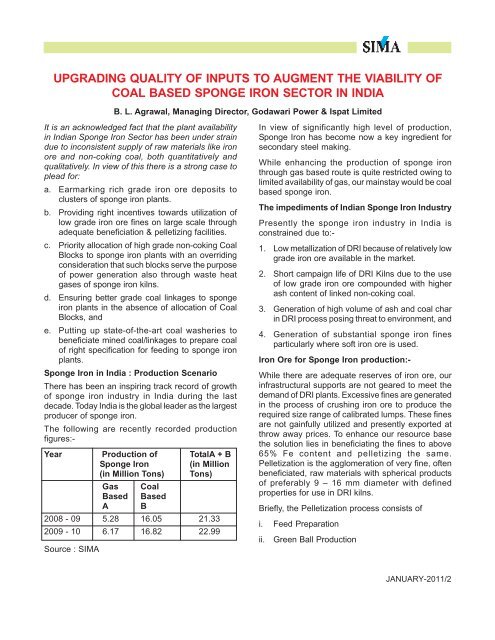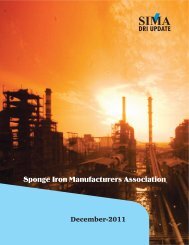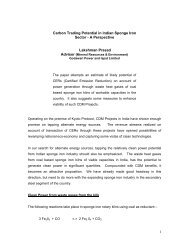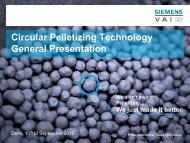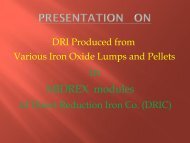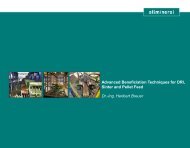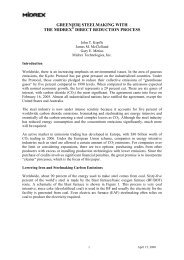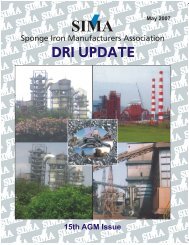sponge iron industry –past-present-future - SIMA
sponge iron industry –past-present-future - SIMA
sponge iron industry –past-present-future - SIMA
You also want an ePaper? Increase the reach of your titles
YUMPU automatically turns print PDFs into web optimized ePapers that Google loves.
UPGRADING QUALITY OF INPUTS TO AUGMENT THE VIABILITY OF<br />
COAL BASED SPONGE IRON SECTOR IN INDIA<br />
It is an acknowledged fact that the plant availability<br />
in Indian Sponge Iron Sector has been under strain<br />
due to inconsistent supply of raw materials like <strong>iron</strong><br />
ore and non-coking coal, both quantitatively and<br />
qualitatively. In view of this there is a strong case to<br />
plead for:<br />
a. Earmarking rich grade <strong>iron</strong> ore deposits to<br />
clusters of <strong>sponge</strong> <strong>iron</strong> plants.<br />
b. Providing right incentives towards utilization of<br />
low grade <strong>iron</strong> ore fines on large scale through<br />
adequate beneficiation & pelletizing facilities.<br />
c. Priority allocation of high grade non-coking Coal<br />
Blocks to <strong>sponge</strong> <strong>iron</strong> plants with an overriding<br />
consideration that such blocks serve the purpose<br />
of power generation also through waste heat<br />
gases of <strong>sponge</strong> <strong>iron</strong> kilns.<br />
d. Ensuring better grade coal linkages to <strong>sponge</strong><br />
<strong>iron</strong> plants in the absence of allocation of Coal<br />
Blocks, and<br />
e. Putting up state-of-the-art coal washeries to<br />
beneficiate mined coal/linkages to prepare coal<br />
of right specification for feeding to <strong>sponge</strong> <strong>iron</strong><br />
plants.<br />
Sponge Iron in India : Production Scenario<br />
There has been an inspiring track record of growth<br />
of <strong>sponge</strong> <strong>iron</strong> <strong>industry</strong> in India during the last<br />
decade. Today India is the global leader as the largest<br />
producer of <strong>sponge</strong> <strong>iron</strong>.<br />
The following are recently recorded production<br />
figures:-<br />
Year Production of TotalA + B<br />
Sponge Iron (in Million<br />
(in Million Tons) Tons)<br />
Gas Coal<br />
Based Based<br />
A B<br />
2008 - 09 5.28 16.05 21.33<br />
2009 - 10 6.17 16.82 22.99<br />
Source : <strong>SIMA</strong><br />
B. L. Agrawal, Managing Director, Godawari Power & Ispat Limited<br />
In view of significantly high level of production,<br />
Sponge Iron has become now a key ingredient for<br />
secondary steel making.<br />
While enhancing the production of <strong>sponge</strong> <strong>iron</strong><br />
through gas based route is quite restricted owing to<br />
limited availability of gas, our mainstay would be coal<br />
based <strong>sponge</strong> <strong>iron</strong>.<br />
The impediments of Indian Sponge Iron Industry<br />
Presently the <strong>sponge</strong> <strong>iron</strong> <strong>industry</strong> in India is<br />
constrained due to:-<br />
1. Low metallization of DRI because of relatively low<br />
grade <strong>iron</strong> ore available in the market.<br />
2. Short campaign life of DRI Kilns due to the use<br />
of low grade <strong>iron</strong> ore compounded with higher<br />
ash content of linked non-coking coal.<br />
3. Generation of high volume of ash and coal char<br />
in DRI process posing threat to env<strong>iron</strong>ment, and<br />
4. Generation of substantial <strong>sponge</strong> <strong>iron</strong> fines<br />
particularly where soft <strong>iron</strong> ore is used.<br />
Iron Ore for Sponge Iron production:-<br />
While there are adequate reserves of <strong>iron</strong> ore, our<br />
infrastructural supports are not geared to meet the<br />
demand of DRI plants. Excessive fines are generated<br />
in the process of crushing <strong>iron</strong> ore to produce the<br />
required size range of calibrated lumps. These fines<br />
are not gainfully utilized and <strong>present</strong>ly exported at<br />
throw away prices. To enhance our resource base<br />
the solution lies in beneficiating the fines to above<br />
65% Fe content and pelletizing the same.<br />
Pelletization is the agglomeration of very fine, often<br />
beneficiated, raw materials with spherical products<br />
of preferably 9 – 16 mm diameter with defined<br />
properties for use in DRI kilns.<br />
Briefly, the Pelletization process consists of<br />
i. Feed Preparation<br />
ii. Green Ball Production<br />
JANUARY-2011/2


